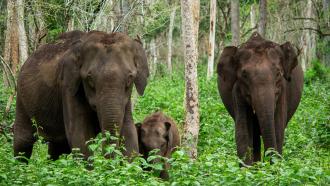![A Himalayan Pierrot (Tarucus venosus) [Image Credits: Pranav Gokhale] Pierrot butterflies take scientists from museum collections to the outdoors and back!](/sites/researchmatters/files/styles/large_800w_scale/public/butterfly12aug.jpg?itok=gmIPlgK-)
A Himalayan Pierrot (Tarucus venosus) [Image Credits: Pranav Gokhale]
India is home to more than 1400 species of colourful butterflies that are divided into six families. Many of them look similar to each other, making it harder to identify and distinguish these butterflies. It is especially true for a genus like Tarucus, which has butterflies with similar wing colour patterns, which also varies seasonally. While some species of this genus are geographically and seasonally restricted to northeastern India and the western Himalayas, rest are widely spread. So how does one identify and classify these little beauties with overlapping wing patterns?
In a study, researchers from the National Centre for Biological Sciences (NCBS), Bangalore have resolved the taxonomic challenge of butterflies in the Tarucus genus, also called Pierrots. Published in the journal Tropical Lepidoptera Research, the study was partially funded by the Department of Science and Technology (DST) and the Council of Scientific Research (CSIR).
The Indian subcontinent has about eight species of the total nineteen species of the Tarucus genus. The last comprehensive work on the taxonomy of these butterflies was done by Brigadier W.H. Evans, a British Army officer, in 1955. In this study, the researchers provide a review of the taxonomy to define and classify the species based on shared characteristics.
“Several recent accounts on Tarucus of the Indian subcontinent were leading to taxonomic ambiguity as for most of the authors, type specimens and historical collections were inaccessible,” says Mr Dipendra Basu, lead author of the study from NCBS. “So it needed a major update of its taxonomy and all possible natural history information,” he adds.
The researchers re-examined the process of naming the species of these butterflies. In an effort spanning 25 years of fieldwork, they provided information about the geographical range and flight periods of the Indian species. Since the genitalia or external sexual organs in butterflies vary and are an essential key in taxonomic identification, the researchers used it to classify the species.
The study also provides details on the early stages of the butterfly life cycles, host plants that the larvae feed on, and parasitoids of the butterfly. It also included an identification key for all the Indian species based on wing colour patterns and the male genitalia of the butterflies. In species with similar wing patterns, the differences in the male genitalia can be used to tell them apart.
Interestingly, many amateur naturalists from all over the country with 10-15 years of experience in butterfly watching and rearing their larvae contributed to the effort. They provide vital information to the online butterfly citizen science platform, Butterflies of India, created, maintained and curated by Dr Krushnamegh Kunte of NCBS.
The researchers and collaborators documented the early stages of Pierrots using butterfly surveys in different localities as well as lab surveys. They photographed physical differences and different stages of the butterflies of this genus. By raising larvae and pupae in plastic jars in laboratories, they confirmed the identification of early stages and species.
The study is a step in systematically understanding the diversity of butterflies in India.
“Butterfly taxonomy in India experienced almost a complete lockdown for half a century post-independence as there was a void in expertise. Prominent European taxonomists, who were working on Butterflies of the Indian region, left”, says Dr Kunte. These taxonomists deposited the butterfly specimens in various European museums and research collections. “For Indian lepidopterists, it is costly and almost impossible to identify and visit these European museums with the specimens of interest, to examine them.”
In India, most of the specimen collection facilities of academic importance are in either national museums or nationally recognized Universities or institutes. It prohibits a citizen scientist from contributing to this exercise or adding more specimens to the collection. With this effort, the researchers have designated and added additional type specimens to the collections in Natural History Museum, London, and the Zoological Survey of India, Kolkata for eight taxa of Tarucus. They have also deposited some specimens, with appropriate permits, in the climate-controlled Research Collections of the NCBS in Bangalore, India.
This article has been run past the researchers, whose work is covered, to ensure accuracy.






